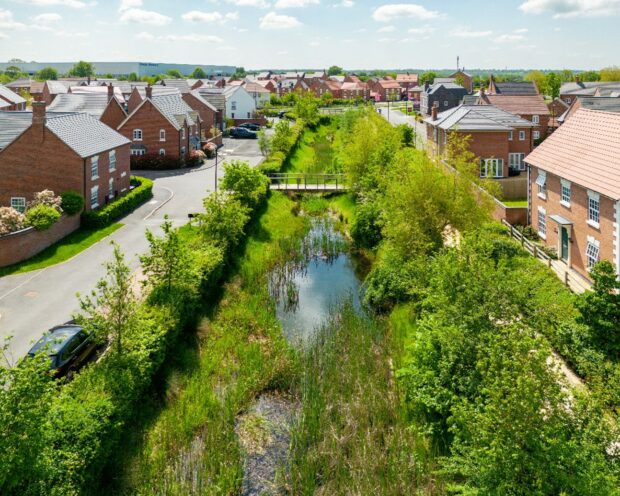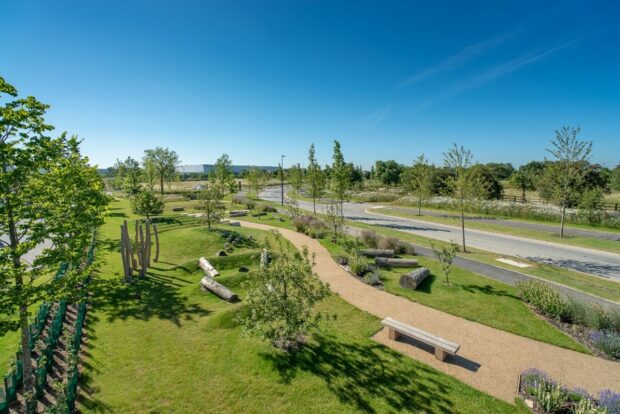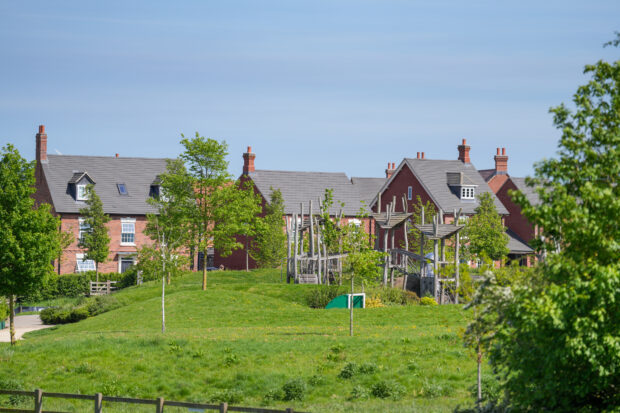
David Drake, Director, People & Nature at Natural England
In January 2023, Natural England launched the Green Infrastructure (GI) Framework to support the creation of good quality Green Infrastructure which maximises benefits for people and nature. GI helps local authorities, communities and developers create better places for people to live, work, learn and relax.
Green infrastructure, ranging from street trees, green roofs and parks through to wildlife areas, woodlands and wetlands, can make a valuable contribution to nature recovery, by creating and connecting places which are rich in wildlife. It provides natural solutions to issues like poor air quality, flood risk and urban heating from climate change, whilst providing accessible spaces where people can enjoy the health and wellbeing benefits of contact with nature. Watch the below clip to learn more about GI.
In September, Natural England will be introducing a range of new and updated resources to help Local Authorities, developers and others embed Green and Blue Infrastructure into strategies, plans and project design. The aim of these is to help us make our towns and cities fit for the future, for people and for nature.
Urban green spaces alone support 2.1 million people in meeting their weekly physical activity needs. This is estimated to be worth £5.6 billion and to avoid health service costs of around £1.4 billion. The new resources come at a time when the need and opportunity for Green Infrastructure creation has never been greater, in addressing a range of priority issues for the government and across society more generally. The importance of high-quality GI is already recognised in the government commitment, contained in the Environmental Improvement Plan, that everyone should live within 15 minutes of green and blue space.
We are also seeing a huge increase in the recognition of how regular contact with nature is beneficial to people’s health and well-being, and the role this can play in the prevention or treatment of a range of long-term health conditions. At the same time, partnerships of local authorities, communities and wider stakeholders are providing the GI knowledge, skills, experiences and connections that enable GI planners and providers to improve their local GI to benefit the local economy, creating the towns and cities of the future.

Since the launch of the Green Infrastructure Framework, we are seeing an increased preparation of GI strategies for Local Plans and the inclusion of GI in some Local Nature Recovery Strategies. The GI Framework and its Standards are also referenced in the consultation on the revisions of the National Planning Policy Framework.
The package of resources being launched in September include:
- An updated version of the Environmental Benefits for Nature Tool, designed to help GI planners maximize the beneficial impacts of their projects across a wide range of nature considerations. It can also assist funders to realise greater returns from their investments by considering the services that nature provides to people, such as flood management, water supply, cooling, and shading.

- A new release of the GI Mapping Tool, with new features including updates on population data from Census 2021, enhancements to greenspace modules such as inequalities and Public Rights of Way, as well as new maps showing outputs from the People and Nature Survey. The original mapping tool, launched in 2021 has proved very popular and was awarded Winner of the Geography in Government Award 2022 Excellence in Geo-visualisation, Version 2.1 of the Mapping Database reflects feedback from users on the additional areas of functionality that would be of most value.
- A substantially updated Process Guide for Local Authorities, providing support on how to use the Green Infrastructure Framework to develop green and blue infrastructure strategy and policy, embed these into local plans and deliver targets. New features include; User Guides for the Headline Standards, checklists, recommended evidence sources, examples of GI Local Plan policies and case studies. This builds on the Process Journey guide for Local Authorities (published in 2023) with similar guides also available for developers and neighbourhood planning groups.
We have also recently seen the government launch of the official statistic in development for the 15 Minute Commitment, called Access to Green Space in England, which calculates the distance to green space for every household in England, measured along a network of walkable streets and paths.
Developing urban greenspace initiative for towns and cities in England
Natural England, National Trust and The National Lottery Heritage Fund are working in partnership on an initiative that puts nature at the heart of our local and national priorities. It will unlock the benefits of improved mental and physical health, greater community cohesion, resilience to climate change, and economic growth for all.
The initiative will support local authorities, partners and community organisations with evidence, tools, funds, and resources to build nature into urban areas. In turn, this will create networks of knowledge and best practice, empowering planners, policymakers and investors to harness nature as an essential building block for better lives.
Together, we are entering a very exciting phase in the journey of Green Infrastructure creation and the recognition of its contribution to society. To find out more about how Natural England can help and support local authorities, developers, community groups and other stakeholders with this journey, watch our recent webinar here:
4 comments
Comment by Ben Reed posted on
Need to add using and protecting the methodology "All Habitats Combined" and recognise its importance on MAGIC maps in planning terms, the DEFRA category for LEW Long Established Woodland from 1893 (Keepers of our Time 2022)
Please, also a national funded programme supporter requests for extending Local Wildlife Sites, new Local Wildlife Sites and new SSSI. Local Knowledge can provide huge insights to Wildlife rich areas needing a designation.
Also, Bats Core Sustenance Zones and IIA Important Invertebrate Areas need more help and recognition. 15m buffer on Woodland does not protect foraging and commuting habitats for bats.
Finally, please can we have bigger buffers on ancient and long established woodlands and implement buffers on SSSI. Building to the borders of SSSI and Local Wildlife Sites is causing harm
Comment by Natural England posted on
Hi Ben, thanks for your comment. In response to the points you raise:
Habitat Networks (Combined Habitats) (England) Dataset - Regarding your recommendation to add the "All Habitats Combined" dataset to the GI Mapping Database, we took a decision not to duplicate datasets in the GI Mapping Database and MAGIC. However, if you would like to view/ combine the All Habitats Combined datasets (‘Habitat Networks (Combined Habitats) (England)’ in MAGIC) with other datasets in the GI Mapping Database, it is possible to download them.
Long Established Woodland - Long established woodland does not currently have specific protection, though its relative value is highlighted in the woodland and trees hierarchy of value in the Keepers of Time policy, and the government is committed to consulting on the protection it should be afforded. Keepers of time: ancient and native woodland and trees policy in England - GOV.UK (www.gov.uk)
Support for designations - Local Wildlife Sites are local sites of importance for biodiversity and should be identified, mapped and safeguarded through the Local Plan (Planning Guidance). A Local Wildlife Sites Partnership, which may be set up by the local authority for their area, has responsibility for selecting sites, and can draw on local knowledge regarding insights to wildlife rich areas needing such designation. Each Partnership determines their own processes and approach to the selection of local sites in their area.
Support for designations - Sites of Special Scientific Interest, Considering a site for designation as a Site of Special Scientific Interest often takes years of evidence gathering and a significant amount of resource to research its special features. Natural England’s designation pipeline is published on Gov.uk at Natural England’s designations programme - GOV.UK (www.gov.uk). The published programme signals where Natural England will focus its designation resources. Natural England has a process to review additions to this programme which is based on the need to ensure the SSSI series as a whole is representative for habitats and species and supports ecological connectivity and the delivery of local nature recovery strategies. In the first instance we recommend that recommendations for additions are discussed with the relevant Area Team via enquiries@naturalengland.org.uk .
Bats Core Sustenance Zones - the revised SSSI selection guidelines for bats promote the inclusion of foraging and commuting areas. Regarding Bats Core Sustenance Zones, the Bat Conservation Trust’s good practice Guidance on Bat Surveys for Professional Ecologists set out the rationale and ways of working relating to these Zones. These guidelines are primarily intended as advice for ecological consultants and also inform all those involved in development activities which may impact bats, for example, developers, planners, Local Planning Authorities, non-government organisations, and licensing authorities.
The Important Invertebrate Areas (IIAs) project Important Invertebrate Areas - Buglife is run by Buglife, The Invertebrate Conservation Trust. It highlights some of the most significant places for rare and threatened invertebrates, and the habitats that support them. IIAs are a valuable tool in conservation by improving awareness of where our special invertebrates occur, e.g. in supporting the creation of Local Nature Recovery Strategies. IIAs complement existing conservation designations for invertebrates provided by Local Wildlife Sites, Local Nature Reserves and SSSIs.
Woodland buffers Regarding your final point asking for ‘bigger buffers on ancient and long-established woodlands and implement buffers on SSSI. Building to the borders of SSSI and Local Wildlife Sites is causing harm’, Forestry Commission/Natural England Standing advice on Ancient Woodland advises that buffer zone size should depend on the nature and scale of the development and its impacts. A buffer zone of at least 15 metres from the boundary of the ancient woodland is required to avoid root damage (known as the root protection area). Where assessment shows other impacts are likely to extend beyond this distance, the proposal is likely to need a larger buffer zone. Buffer zone size also depends on the character of the area, e.g. larger buffer zones are more likely to be needed if the surrounding area is: sparsely wooded, close to residential areas, steeply sloped. Ancient woodland, ancient trees and veteran trees: advice for making planning decisions - GOV.UK (www.gov.uk)
SSSIs and buffers The Guidelines for the Selection of Biological Sites of Special Scientific Interest (SSSIs) Guidelines for selection of SSSIs | JNCC - Adviser to Government on Nature Conservation provide guidance on the selection of SSSIs for a range of habitats and species and on the determination of site boundaries. Most of the species and habitat chapters have been revised since 2018. In many cases the revisions include advice on buffers to allow for natural processes such as river channel movement and coastal erosion or to ensure the sustainability of features. Natural England’s designation programme includes both new SSSIs and the renotification of existing SSSIs.
Comment by Geraldine Berryman posted on
Surely a plan to preserve the nature we have left might be better than building in green spaces to new developments - to me it looks a bit like carbon offsetting.
Which is basically just a way to make destruction of natural established habitat look better on paper.
I see National Grid getting permission to build giant power plants on area of environmentally sensitive marshlands when they could be located off shore.
Or on brown field sites.
Surely this is what we should be focussing on rather than GIs..and a few saplings here and there…
Comment by Natural England posted on
Natural England is a statutory adviser within the planning system, and we provide advice in accordance with the National Planning Policy Framework. The GI Framework is designed to ensure that GI is much more than simply a few saplings planted here and there. It’s about taking a strategic and evidence-based approach to the natural environment through the planning system and guided by the Local Nature Recovery Strategy. Delivering high quality greenspaces including nature rich habitats in consultation with local communities, not only benefits wildlife but is also good for people’s health and wellbeing, climate resilience and air quality etc.
In the planning sector, Natural England provides environmental advice on applications for Nationally Significant Infrastructure projects, with discussions on the environment often starting at the pre-application stage. When advising on NSIP applications, we not only focus on protecting the natural environment by ensuring development is sited appropriately, but also encourage developers to enhance the local environment and to include a strong GI component. This has potential to improve ecological connectivity and to provide new areas of habitat to complement the local natural environment.
At Natural England, our core remit is to conserve and enhance the natural environment, we have a significant role in land management protecting SSSIs, NNRs and protected landscapes. All are vital to preserving the nature we have left and creating new areas for the national Nature Recovery Network across England.